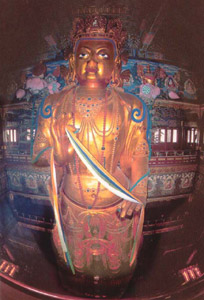| Tools: Save | Print | E-mail | Most Read |
| Yonghegong Lama Temple |
| Adjust font size: |
At the northeast corner of
Built initially in 1694 during the Qing Dynasty, this building was the residence of Emperor Yongzheng when he was just a prince. However, in 1744 the Qing Dynasty formally changed the status of the dwelling to that of a lamasery, and so Yonghe Lamasery became the national center of Lama administration. The following details describe the main buildings inside the Lamasery. On arrival at the south end of Yonghe Lamasery, the visitor will enter a yard which contains a screen wall and three Paifangs (Gateways), and will observe the red walls and stone lions, symbols which show that this Lamasery was originally the dwelling of
Passing through Zhaotai Gate the visitor will enter the second yard which contains a
On departing Devaraja Hall the visitor will immediately observe an ancient copper cooking vessel made in 1747 during the Qing Dynasty. This vessel, which appears to be black with white marble stone as its seat, has high artistic value and is among 'the three rarest things in
North of the Hall of Harmony and Peace is Yongyoudian (Hall of Everlasting Protection), which was Emperor Yongzheng's living room when he lived there as a young prince and, at the time of his death his coffin was placed there. Now, a statue of Bhaisajya-guru is located there and sacrificial offerings are made to it. From Yongyoudian continue north to the Falundian (Hall of the Wheel of the Law), which is the location for Lamas reading scriptures and holding Buddhist ceremonies. The Falundian comprises very special features as its structure contains the architectural styles of both Tibetan and Han Nationalities. It was formerly the dwelling of the Emperor's wives. A large statue of Tsong Kha-pa, an ancestor of Lamaism is displayed here in the centre of the Hall and also receives sacrificial offerings. Behind this statue is an Arhat Hill containing 500 Arhats made of five kinds of metals--gold, silver, copper, iron and tin. These Arhats have been shaped in different poses. In front of this Hill is a wooden basin which was said to have been used for washing the body of Emperor Qianlong three days after his birth. Elegant large frescos illustrating the life of Sakyamuni stretch around both the east and west walls. Wanfuge (Pavilion of Ten Thousand Happinesses) is the last formal palace to be visited in this complex. This is the highest palace because it is three stories high. Inside this pavilion there are tens of thousands of Buddhas displayed along every level, and in the center there is an enormous statue of Maitreya positioned on a white marble base. Travel tips:
Add: Andingmen Dongdajie, Dongcheng District. 010- 6404 9027. Ticket: 25 yuan. Opening hours: 09:00 - 17:00 How to get there: Bus routes: 13, 62, 44, 406 at Yonghegong station; or take the subway to arrive at Yonghegong.
(China.org.cn travelchinaguide.com May 25, 2007) |
| Tools: Save | Print | E-mail | Most Read |
 |
| Related Stories |



